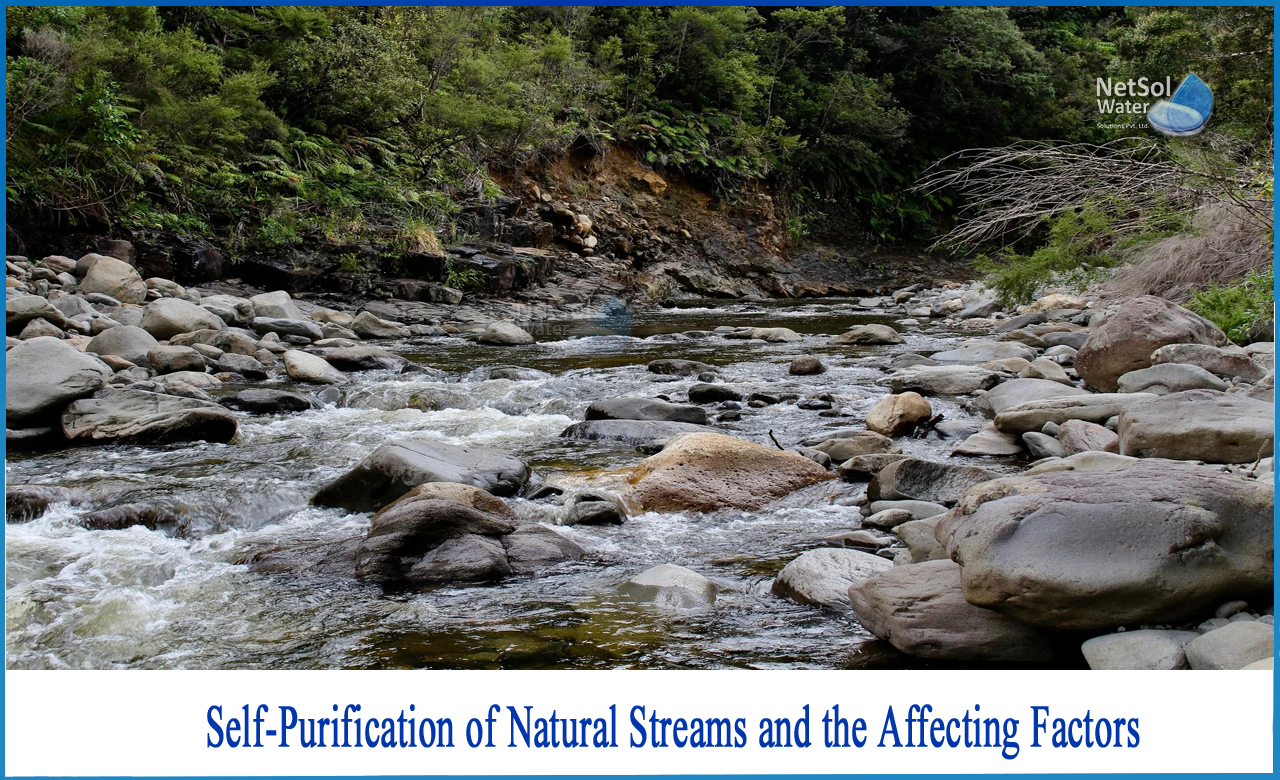What is self purification of natural streams?
Natural water systems self-purification is a complicated process that frequently involves physical, chemical, and biological processes all operating at the same time. One of the most often used measures of river health is the amount of dissolved oxygen (DO) in the water.
When DO falls below 4 or 5 mg/L, the type of life that can survive start to reduce. Higher living forms require a dissolved oxygen concentration of at least 2.0 mg/L.
The amount of DO in a river is influenced by a number of factors-
Oxygen-demanding wastes diminish DO; plants add DO during the day but deplete it at night; and organism’s respiration depletes oxygen.The solubility of oxygen decreases as the temperature rises in the summer, and lower flows slow down the rate at which oxygen penetrates the water from the atmosphere.
Self-Purification & the factors affecting it
1. Dilution: When enough dilution water is present in the receiving water body in which the wastewater is discharged, the DO level in the receiving stream may not reach zero or critical DO due to the presence of sufficient DO in the river water prior to receiving the wastewater discharge.
2. Current: When there is a strong water current, the discharged wastewater is thoroughly mixed with stream water, preventing solid deposition. Following breakdown and a reduction in DO, the solid matter from the wastewater is deposited to the bed in a tiny stream.
3. Temperature: In cold temperatures, the amount of DO accessible in stream water is greater than in hot temperatures. Also, because microbe activity is stronger at higher temperatures, self-purification will take less time in the summer than in the winter.
4. Sunlight: Algae produces oxygen through photosynthesis when exposed to sunlight. As a result, sunlight aids in stream cleansing by supplying oxygen via photosynthesis.
5. Rate of Oxidation: DO depletion occurs as a result of the oxidation of organic waste discharged into the river. At higher temperatures, this rate is faster, whereas at lower temperatures, it is slower. The rate of oxidation of organic matter is determined by its chemical composition.
Analysis of Oxygen Depletion
The difference between the saturation DO content and the actual DO content at any point throughout the self-purification process is the oxygen sag or oxygen deficit in the stream.
D (Oxygen Deficit) = Saturation DO – Actual DO
The saturation DO value for fresh water fluctuates depending on temperature and total dissolved salts present, ranging from 14.62 mg/L at 0° C to 7.63 mg/L at 30° C, with lower DO at higher temperatures.
There may be an initial oxygen deficiency “Do” because DO in the stream is not at saturation level.When effluent with an initial BOD load “Lo” is discharged into a stream, the stream's DO level begins to deplete, and the oxygen deficit (D) grows. In sag analysis, the point of minimal DO, or maximum deficiency, is the most important. At the inflexion points of the oxygen sag curve, the greatest or critical deficit (Dc) occurs.
Conclusion
Netsol is one of the leading water and wastewater treatment company in India offering projects and services in the field of water and wastewater treatment plant manufacturing and supplying machines like compact sewage treatment plants which not only turns your waste water into usable water but also acts as a saviour of Mother earth and its precious resource “water”.
Netsol Water is Greater Noida-based leading water & wastewater treatment plant manufacturer. We are industry's most demanding company based on client review and work quality. We are known as best commercial RO plant manufacturers, industrial RO plant manufacturer, sewage treatment plant manufacturer, Water Softener Plant Manufacturers and effluent treatment plant manufacturers. Apart from this 24x7 customer support is our USP. Call on +91-9650608473, or write us at enquiry@netsolwater.com for any support, inquiry or product-purchase related query.



